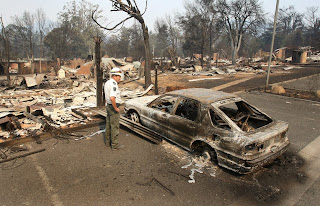The state of Victoria in southern Australia has recently been hit with hundreds of bush fires during a record-breaking heatwave - temperatures well above 38°C (100°F). Unfortunately, these fires have proved to be the deadliest in Australian history, with at least 166 deaths reported so far. The fires mostly appear to have been started by lightning - however a few appear to have been arson, and are under investigation - entire towns being declared crime scenes. Twenty-four fires are still burning, and authorities warn that the death toll will likely rise.
 A fire truck moves away from out of control flames from a bushfire in the Bunyip Sate Forest near the township of Tonimbuk, 125 kilometers (78 miles) west of Melbourne, Saturday, Feb. 7, 2009. Walls of flame roared across southeastern Australia, razing scores of homes, forests and farmland in the sunburned country's worst wildfire disaster in a quarter century. (AP Photo)
A fire truck moves away from out of control flames from a bushfire in the Bunyip Sate Forest near the township of Tonimbuk, 125 kilometers (78 miles) west of Melbourne, Saturday, Feb. 7, 2009. Walls of flame roared across southeastern Australia, razing scores of homes, forests and farmland in the sunburned country's worst wildfire disaster in a quarter century. (AP Photo) Flames and smoke rise from a bushfire in the Bunyip Sate Forest west of Melbourne, Saturday, Feb. 7, 2009. (AP Photo)
Flames and smoke rise from a bushfire in the Bunyip Sate Forest west of Melbourne, Saturday, Feb. 7, 2009. (AP Photo) A Country Fire Authority (CFA) Sector Commander looks up at a giant fire raging in the Bunyip State Park near Labertouche, Australia, on February 7, 2009. More than 40 blazes raged across two states as a once-in-a-century heatwave pushed the mercury as high as 46 degrees Celsius (115 Fahrenheit) with fire bans in place across much of the south-east. (WILLIAM WEST/AFP/Getty Images)
A Country Fire Authority (CFA) Sector Commander looks up at a giant fire raging in the Bunyip State Park near Labertouche, Australia, on February 7, 2009. More than 40 blazes raged across two states as a once-in-a-century heatwave pushed the mercury as high as 46 degrees Celsius (115 Fahrenheit) with fire bans in place across much of the south-east. (WILLIAM WEST/AFP/Getty Images) A general view of the devastation from the Peats Ridge Valley bushfire on February 9, 2009 in Peats Ridge, Australia. (Brendon Thorne/Getty Images)
A general view of the devastation from the Peats Ridge Valley bushfire on February 9, 2009 in Peats Ridge, Australia. (Brendon Thorne/Getty Images) A firefighter tries to contain a bushfire approaching the town of Peats Ridge, north of Sydney, on February 8, 2009.
A firefighter tries to contain a bushfire approaching the town of Peats Ridge, north of Sydney, on February 8, 2009. Small acreage is burned out in Kinglake, northeast of Melbourne, Australia, Sunday, Feb. 8, 2009. (AP Photo/Rick Rycroft)
Small acreage is burned out in Kinglake, northeast of Melbourne, Australia, Sunday, Feb. 8, 2009. (AP Photo/Rick Rycroft) Senior Wildlife Officer Geoff McClure inspects the fire front at Mt. Cathederal, near Alexandra, some 120 kilometres northeast of Melbourne on February 9, 2009. (WILLIAM WEST/AFP/Getty Images)
Senior Wildlife Officer Geoff McClure inspects the fire front at Mt. Cathederal, near Alexandra, some 120 kilometres northeast of Melbourne on February 9, 2009. (WILLIAM WEST/AFP/Getty Images) Senior Wildlife Officer Geoff McClure looks over the destruction in the main street of Marysville, some 100 kilometres northeast of Melbourne on February 9, 2009. The wildfires have become the deadliest in Australia's history, destroying entire towns and wiping out families and amid the heartache there was also anger as police revealed they suspected some of the fires were started by arsonists. (WILLIAM WEST/AFP/Getty Images)
Senior Wildlife Officer Geoff McClure looks over the destruction in the main street of Marysville, some 100 kilometres northeast of Melbourne on February 9, 2009. The wildfires have become the deadliest in Australia's history, destroying entire towns and wiping out families and amid the heartache there was also anger as police revealed they suspected some of the fires were started by arsonists. (WILLIAM WEST/AFP/Getty Images) Family members react after learning that their parents Bill and Faye Walker and disabled brother Geoffrey were killed in wildfires in Marysville, north of Melbourne, Monday, Feb. 9, 2009. (AP Photo)
Family members react after learning that their parents Bill and Faye Walker and disabled brother Geoffrey were killed in wildfires in Marysville, north of Melbourne, Monday, Feb. 9, 2009. (AP Photo) A burnt out house is seen following the bushfires that swept through the region on February 9, 2009 in Christmas Hills, Australia. (Lucas Dawson/Getty Images
A burnt out house is seen following the bushfires that swept through the region on February 9, 2009 in Christmas Hills, Australia. (Lucas Dawson/Getty Images A burnt out house and a car are seen at the township of King Lake, north east of Melbourne, Sunday, Feb. 8, 2009. Towering flames razed entire towns in southeastern Australia and burned fleeing residents in their cars as the death toll from the country's worst fire disaster in a quarter-century reached 65 on Sunday. (AP Photo/Stringer
A burnt out house and a car are seen at the township of King Lake, north east of Melbourne, Sunday, Feb. 8, 2009. Towering flames razed entire towns in southeastern Australia and burned fleeing residents in their cars as the death toll from the country's worst fire disaster in a quarter-century reached 65 on Sunday. (AP Photo/Stringer










No comments:
Post a Comment